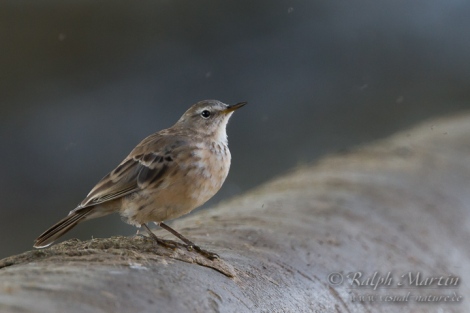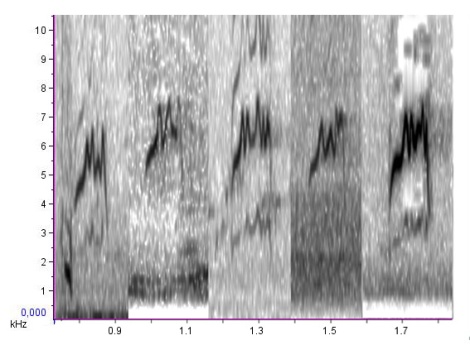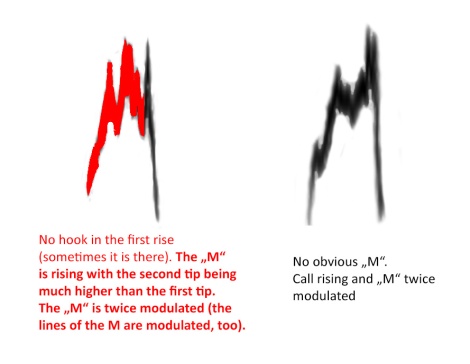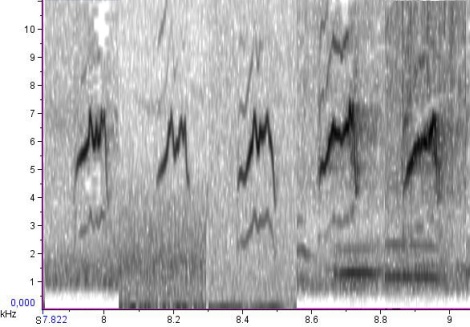The Water Pipit is a widespread breeder in the Palearctic, occuring in three subspecies: the nominate inhabits most of Europe, ssp. coutellii from the Bosporus eastwards to Iran and ssp. blakistoni in China and Mongolia. The differences in plumage are slight: ssp. coutellii has a weaker malar stripe, paler, more streaked upperparts and in breeding plumage a more extensive pink-yellow coloured belly than the nominate form. In winter plumage the belly is streaked on yellowish background (van Duivendijk 2011).
Caucasian Water Pipit (Anthus spinoletta coutellii), worn ind., 11.02.2013, Muntasar, Oman. Note the pale upperparts, obvious streaking on the back and intense yellowish-brown flanks. The streaking is less extensive and the streaks themselves smaller than in the nominate form. 
Caucasian Water Pipit, 28.01.2013, Sohar-Sun-Farms, Oman. Early moulting bird: most of the body feathers already moulted, tertials also moulted. Note the extensive roseate-orange colour of the underparts.
The ssp. blakistoni is even paler and more streaked on the back and lacks a loral stripe altogether. The underparts in breeding plumage are (almost) unmarked and less intensively coloured. All in all it bears more resemblance to a Buff-bellied Pipit and is a potential id pitfall. Alström et al. 2003 describe the call of ssp. blakistoni as „[…] usually sounds more like spinoletta than coutellii […]“.
Here we are going to discuss the flight calls of ssp. coutellii which haven’t received much attention so far.
Data set
We analysed 117 calls from 21 recordings from Cyprus in March/April 2013 and from the Sultanate of Oman in November 2012 and February 2013. More than 100 calls of ssp. spinoletta were analysed, the majority coming from www.xeno-canto.org.
Description of the flight call:
NOTE: The calls of Water Pipits are quite variable and also vary depending on the situation! Here we concentrate on calls that are given in flight!
In sonagrams of flight calls of ssp. coutellii there is one regularly occuring, distinctive pattern: the „M“. In contrast to the nominate form the call sounds less rising in pitch or even descending (easier to see in the sonagram but sometimes also well audible in the field).
 Typical flight call of ssp. coutellii.
Typical flight call of ssp. coutellii.
Flight calls of ssp. spinoletta.
A few more examples:
 Flight calls of different Water Pipits of the ssp. coutellii: Recording 1: 25.03.2013, Cape Greco, Cyprus © J. Honold / Recording 2: 28.01.2013, Sohar-Sun-Farms, Oman. © R. Martin / Recording 3: 27.01.2013, Sohar-Sun-Farms, Oman © R. Martin, same individuum as in recording 2 / Recording 4: 08.04.2013, Cape Greco, Cyprus © J. Honold / Recording 5: 25.03.2013, Cape Greco, Cyprus © J. Honold.
Flight calls of different Water Pipits of the ssp. coutellii: Recording 1: 25.03.2013, Cape Greco, Cyprus © J. Honold / Recording 2: 28.01.2013, Sohar-Sun-Farms, Oman. © R. Martin / Recording 3: 27.01.2013, Sohar-Sun-Farms, Oman © R. Martin, same individuum as in recording 2 / Recording 4: 08.04.2013, Cape Greco, Cyprus © J. Honold / Recording 5: 25.03.2013, Cape Greco, Cyprus © J. Honold.
Flight calls of different Water Pipits ssp. spinoletta: Recording 1: 19.12.2008, Hulkesteinse Bos, Zeewolde, Netherlands © Ruud van Beusekom / Recording 2: 3.4.2011, Poland, © Jarek Matusiak / Recording 3: 30.09.2011, Poland, © Jarek Matusiak / Recording 4: 06.03.2013, Mohrhof-Weihergebiet, BY, Germany © Matthias Bull / Recording 5: 06.03.2013, Mohrhof-Weihergebiet, BY, Germany © Matthias Bull
Variation
As you can tell from the sonagrams, the calls of the nominate form are quite variable! Some calls resemble those of ssp. coutellii in the sonagram.
 Variation of flight calls of ssp. spinoletta: Recording 1: 03.04.2011, Tarnawa Niżna, Poland © Jarek Matusiak; second tip of the „M“ higher than the first / Recording 2: 06.03.2013, Mohrhof-Weihergebiet, BY, Germany © Matthias Bull; call rising, M indistinct and second tip higher than first / Recording 3: 03.04.2011, Tarnawa Niżna, Poland © Jarek Matusiak; M much like coutelli but shorter and total length of call longer with additional modulations. Recording 4: February 2008, Beddington Farm, United Kingdom © Stuart Fisher; M as in typical coutellii, rest of call much higher. We haven’t seen this in recordings of ssp. coutellii. (Meadow Pipit in the background!); Recording 5: 19.12.2008, Hulkesteinse Bos, Zeewolde, Netherlands © Ruud van Beusekom; M resembling ssp. coutellii but rising after the M.
Variation of flight calls of ssp. spinoletta: Recording 1: 03.04.2011, Tarnawa Niżna, Poland © Jarek Matusiak; second tip of the „M“ higher than the first / Recording 2: 06.03.2013, Mohrhof-Weihergebiet, BY, Germany © Matthias Bull; call rising, M indistinct and second tip higher than first / Recording 3: 03.04.2011, Tarnawa Niżna, Poland © Jarek Matusiak; M much like coutelli but shorter and total length of call longer with additional modulations. Recording 4: February 2008, Beddington Farm, United Kingdom © Stuart Fisher; M as in typical coutellii, rest of call much higher. We haven’t seen this in recordings of ssp. coutellii. (Meadow Pipit in the background!); Recording 5: 19.12.2008, Hulkesteinse Bos, Zeewolde, Netherlands © Ruud van Beusekom; M resembling ssp. coutellii but rising after the M.
But sometimes the „M“ is less distinct or not even recognisable in ssp. coutellii, too. This seems to be more often the case in calls of sitting birds but at times also in calls of flying birds.
 Water Pipit ssp. coutellii, 11.02.2013, Muntasar, Oman. Calls of a sitting bird (pauses between calls are cut). Hints of the „M“ are visible in the first and last call. Still the pitch is not rising.
Water Pipit ssp. coutellii, 11.02.2013, Muntasar, Oman. Calls of a sitting bird (pauses between calls are cut). Hints of the „M“ are visible in the first and last call. Still the pitch is not rising.
Conclusion
The flight calls of both subspecies are variable but in ssp. coutellii many calls show the same basic structure („M“). Some birds of the nominate form have similar calls; most of these similar calls are given only once in a series of calls or if they have the „M“, the ending is different. It is probably not possible to identify a Caucasian Water Pipit in western Europe by call only, however it could be a supporting feature. More recordings of ssp. coutellii and eastern spinoletta would be interesting. There might be a cline in the calls as there is a mixed population in western Turkey (Shirihai 1996); in fact, some of our recordings from Cyprus might be of these birds.
Thanks to everybody that provided us with recordings!
References
Alström, Mild & Zetterström (2003): Pipits and Wagtails of Europe, Asia & North America. Christopher Helm Verlag
van Duivendijk, N. (2010) Advanced Bird ID Guide: The Western Palearctic. New Holland
Shirihai (1996): The Birds of Israel. Academic Press Limited, London
_________________________________
Edited 6th February 2015: changed caption of first image in chapter „Variation“. „ssp. spinoletta“ instead of „ssp. coutellii“




Pingback: Water Pipit | health·